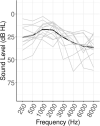Listening Over Time: Single-Trial Tonic and Phasic Oscillatory Alpha-and Theta-Band Indicators of Listening-Related Fatigue
- PMID: 35720726
- PMCID: PMC9198355
- DOI: 10.3389/fnins.2022.915349
Listening Over Time: Single-Trial Tonic and Phasic Oscillatory Alpha-and Theta-Band Indicators of Listening-Related Fatigue
Abstract
Objectives: Listening effort engages cognitive resources to support speech understanding in adverse listening conditions, and leads to fatigue over the longer term for people with hearing loss. Direct, neural measures of listening-related fatigue have not been developed. Here, event-related or phasic changes in alpha and theta oscillatory power during listening were used as measures of listening effort, and longer-term or tonic changes over the course of the listening task were assessed as measures of listening-related fatigue. In addition, influences of self-reported fatigue and degree of hearing loss on tonic changes in oscillatory power were examined.
Design: Participants were middle-aged adults (age 37-65 years; n = 12) with age-appropriate hearing. Sentences were presented in a background of multi-talker babble at a range of signal-to-noise ratios (SNRs) varying around the 80 percent threshold of individual listeners. Single-trial oscillatory power during both sentence and baseline intervals was analyzed with linear mixed-effect models that included as predictors trial number, SNR, subjective fatigue, and hearing loss.
Results: Alpha and theta power in both sentence presentation and baseline intervals increased as a function of trial, indicating listening-related fatigue. Further, tonic power increases across trials were affected by hearing loss and/or subjective fatigue, particularly in the alpha-band. Phasic changes in alpha and theta power generally tracked with SNR, with decreased alpha power and increased theta power at less favorable SNRs. However, for the alpha-band, the linear effect of SNR emerged only at later trials.
Conclusion: Tonic increases in oscillatory power in alpha- and theta-bands over the course of a listening task may be biomarkers for the development of listening-related fatigue. In addition, alpha-band power as an index of listening-related fatigue may be sensitive to individual differences attributable to level of hearing loss and the subjective experience of listening-related fatigue. Finally, phasic effects of SNR on alpha power emerged only after a period of listening, suggesting that this measure of listening effort could depend on the development of listening-related fatigue.
Keywords: EEG; alpha; fatigue; hearing; listening effort; oscillatory power; speech perception; theta.
Copyright © 2022 Hunter.
Conflict of interest statement
The author declares that the research was conducted in the absence of any commercial or financial relationships that could be construed as a potential conflict of interest.
Figures





Similar articles
-
Impact of Effortful Word Recognition on Supportive Neural Systems Measured by Alpha and Theta Power.Ear Hear. 2022 Sep-Oct 01;43(5):1549-1562. doi: 10.1097/AUD.0000000000001211. Epub 2022 Apr 1. Ear Hear. 2022. PMID: 35363640
-
EEG activity as an objective measure of cognitive load during effortful listening: A study on pediatric subjects with bilateral, asymmetric sensorineural hearing loss.Int J Pediatr Otorhinolaryngol. 2017 Aug;99:1-7. doi: 10.1016/j.ijporl.2017.05.006. Epub 2017 May 17. Int J Pediatr Otorhinolaryngol. 2017. PMID: 28688548
-
Validity and reliability of self-reported and neural measures of listening effort.Eur J Neurosci. 2023 Dec;58(11):4357-4370. doi: 10.1111/ejn.16187. Epub 2023 Nov 20. Eur J Neurosci. 2023. PMID: 37984406
-
Hearing Aid Noise Reduction Lowers the Sustained Listening Effort During Continuous Speech in Noise-A Combined Pupillometry and EEG Study.Ear Hear. 2021 Nov-Dec 01;42(6):1590-1601. doi: 10.1097/AUD.0000000000001050. Ear Hear. 2021. PMID: 33950865
-
Performance Monitoring and Cognitive Inhibition during a Speech-in-Noise Task in Older Listeners.Semin Hear. 2023 Apr 28;44(2):124-139. doi: 10.1055/s-0043-1767695. eCollection 2023 May. Semin Hear. 2023. PMID: 37122879 Free PMC article. Review.
Cited by
-
Investigation of the behavior of tinnitus patients under varying listening conditions with simultaneous electroencephalography and pupillometry.Brain Behav. 2024 Jun;14(6):e3571. doi: 10.1002/brb3.3571. Brain Behav. 2024. PMID: 38841736 Free PMC article.
References
-
- Antons J.-N., Schleicher R., Arndt S., Moller S., Curio G. (2012). “Too tired for calling? A physiological measure of fatigue caused by bandwidth limitations,” in 2012 Fourth International Workshop on Quality of Multimedia Experience, (Melbourne: IEEE; ), 63–67. 10.1109/QoMEX.2012.6263840 - DOI
LinkOut - more resources
Full Text Sources

